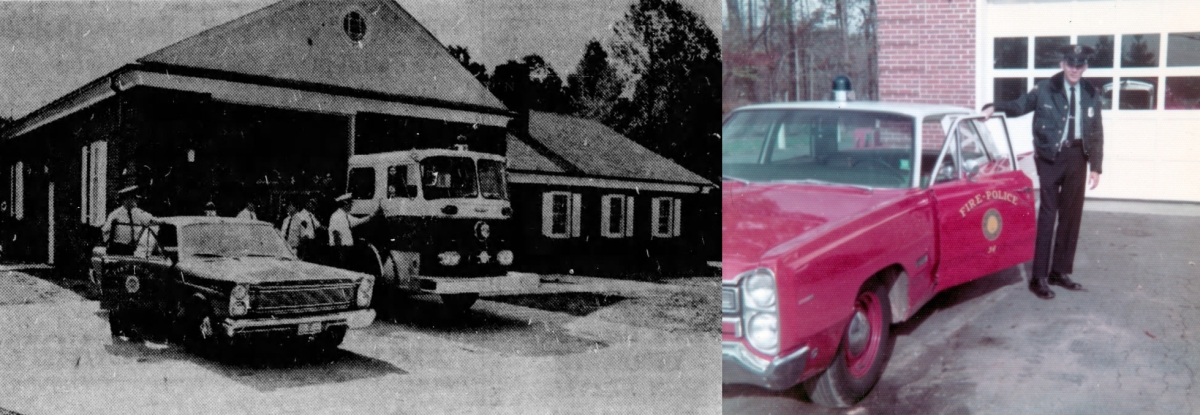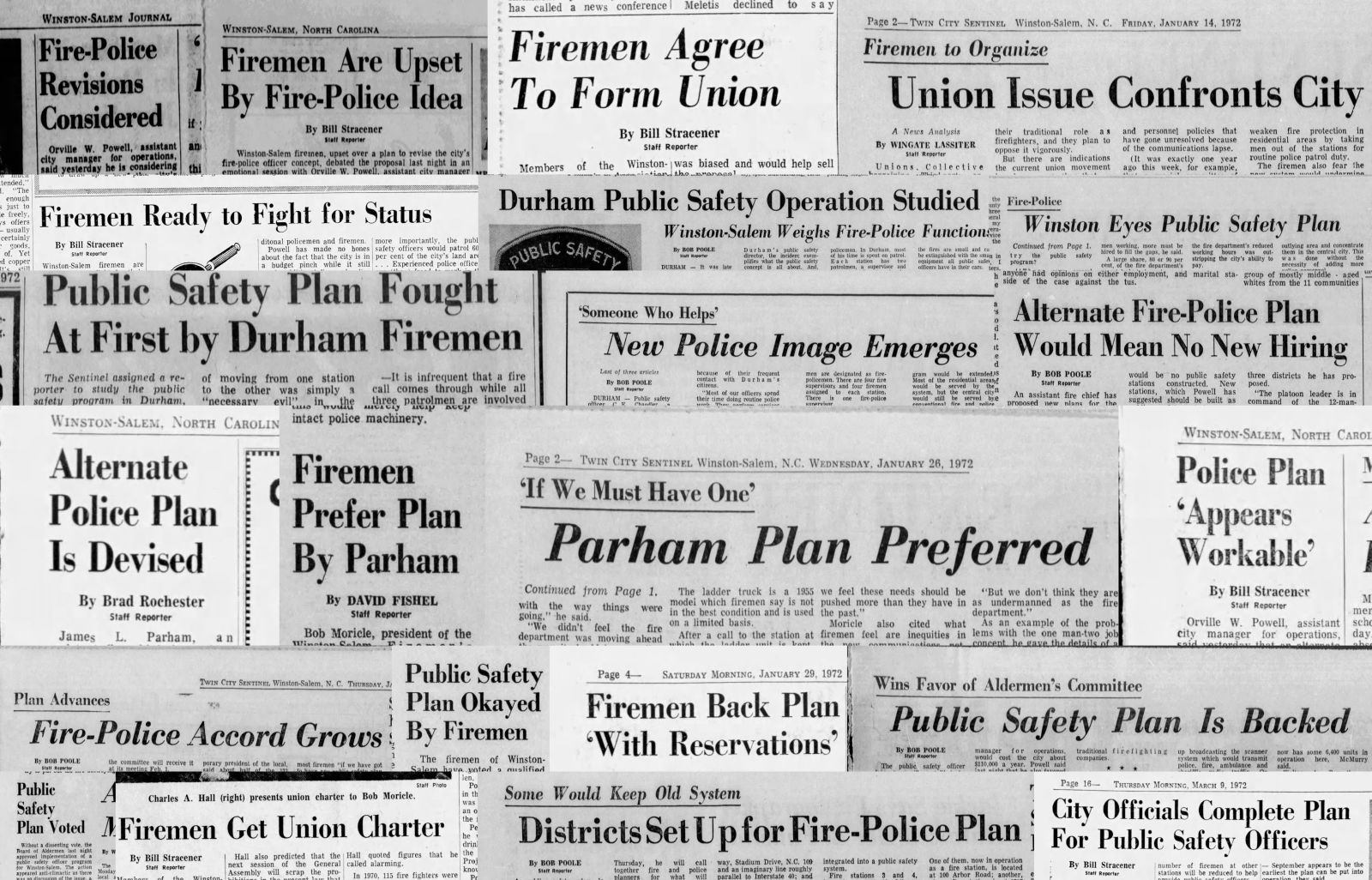Research notes on Winston-Salem’s fire police program (1957-1973) and public safety officer program (1973-1987)
See source materials via Google Drive
Fire Police
1956, Jul – City Manager sent 10-page memo to Board of Alderman, with detailed reasons to try a fire-police “safety patrol” on a “limited, experimental basis.” [WSJ, 7/10/56]
1957, Jan 30 – City Manager recommended established “combined fire-and-police patrol” at the new Station 8. Recommendation to be considered by city alderman’s Public Safety Committee. [WSS, 1/30/57]
1957, Apr – Nine volunteers from the fire department began first phase of training as “fire-police patrolmen.” They started classes at 8:00 a.m. at the “Police Pistol Club” and the training lasted four weeks. Subjects included “City ordinances, North Carolina laws, methods of arrest, self protection, arms instruction, police courtesy, and court testimony procedure.” After their training, they will have a month of on-the-job training as police officers. [WSJ, 4/11/57]
1957, May – Names of personnel assigned to new Station 8 and those assigned to fire-police patrol were announced. [WSS, 5/16/57]
1957, Sep 2 – Fire-police patrol placed in service with a 1957 Chevrolet station wagon. Housed at Station 7 until its permanent quarters at Station 8 were completed. [WSJ, 10/13/57]
1957, Oct 13 – Fire police patrol had been operating for a month, and logged more than 1,000 hours of “watchful scouting.” The unit was moving into new Station 8 that week. [WSJ, 10/13/57]
1957, Oct 30 – Fire police car involved in collision with a second vehicle, while chasing a speeder on Reynolda Road at 10:30 p.m. No injures. The speeder “got away.” There was slight damage to the patrol car. [WSJ, 10/31/57]
1957, Nov – Second phase of fire-police training program started. Fourteen men would take a 172-hour fire training course. Class would be taught by a “21-man faculty” and include using tools and equipment, ladders in the fire service, hydraulics and hose layouts, dual pump operations, advancing hose, securing lines to upper stories, use of gas masks, ventilation, first aid and rescue operations, and coordination of services. They would be trained in fire suppression, fire prevention, arson detection, and “field problems.” [WSS, 5/11/57]
1958, Jan – Fire Chief released four-month report on December 31. The unit answered 29 fire alarms, spent 15.5 hours fighting fires, and seven hours of firefighter training. They spent 70 hours inspecting 445 homes, and made 272 hydrant inspections. They answered 99 police calls. They discovered 10 fires and two emergencies, during patrols. They made 239 arrests and 938 residential checks. They recovered $650 in property, spent 212 hours on speed checks, and issued nine parking tickets. They found 246 street lights out, two traffic lights out, and subpoenaed six witnesses. [WSJ, 1/21/58]
1958, Jan 27 – Fire police car stolen from fire station around midnight. It was parked outside Station 8, “with the keys in the switch.” It was found the next morning in a lake at the Old Town Club golf course. [WSS, 1/28/58]
1958, May – City manager, fire chief, and police chief issued joint report of program, noting the success of the trail period from September 9, 1957, to March 31, 1958. They noted the program would save taxpayers over $20,000 annually. [WSS, 5/19/58]
1958, May – Public safety committee recommended extending the program to other parts of town, but did not specify the specific area for a second patrol unit. [WSJ, 5/28/58]
1958, Oct – National Board of Fire Underwriters issued report that the fire police program was “generally satisfactory.” [WSJ, 8/28/58]
1965, May 18 – Station 9 opened on Ogburn Road and both Engine 9 and a new, second fire-police unit were moved from Station 3. Both were activated on June 1, 1964, at that location. [WSS, 5/18/65]
Public Safety Officers
1967, July – City officials reported that a long-range study was underway on the feasibility of combining the separate police and fire departments into a single public safety department. [WSS, 7/12/67]
1971, Dec – City officials said they were considering reorganizing parts of the fire and police departments. One proposal under consideration was making fire-police officers public safety officers. The draft proposal recommended that two fire stations planned for construction be operated as public safety stations, and that Station 8 and Station 9 be converted to public safety stations. [WSJ, 12/11/71, 12/17/71]
1971, Dec 16 – Some 100 firefighters attended a meeting with city officials, to debate and express displeasure with the proposed public safety program. [WSJ, 12/17/71]
1972, Jan 12 – Fire department members agreed to organize a local chapter of the IAFF, with 131 members committed to joining, about 70 percent. The members opposed a proposed change to a public safety department, and sought assistance from the national organization. [WSJ, 1/13/72]
1972, Jan – Fire department officials proposed a new plan for the proposed public safety program, that would utilize existing fire department personnel and save the city about $500,000 annually, instead of hiring new personal. Under his plan, public safety officers would operate from “conventional fire stations.” [WSS, 1/25/72]
1972, Jan – Fire department members, in a majority vote, voted a qualified approval of the alternate plan proposed by fire officials, for the proposed public safety program. But they would still register opposition to the overall program. (WSS, 1/29/72)
1972, Feb 7 – Board of Alderman approved implementing new public safety program, as a pilot program to test the workability of the concept. It would be tested initially at Station 10 and Station 11, both to built soon. [WSS, 2/8/72]
1972, Feb – The Winston-Salem Firemen’s Association received their IAFF charter. [WSJ, 2/18/72]
1972, Mar – Public Safety Officer program plan completed by city officials. Planned were 58 public safety officers. The city was divided into four districts. In three, public safety officers would operate:
Sector 1 – Sta 8, Sta 9
Sector 2 – Sta 7, Sta 10 (planned station)
Sector 3 – Sta 5 (new location planned), Sta 11 (planned station)
Sector 4 – Sta 1, 2, 3, 4, 5 – No public safety officers. The area includes the core downtown.
Also, the proposal would reorganize the fire and police communication systems into one. [WSJ, 3/9/72, 3/12/72]
1973, July 1 – Public Safety Officer program placed in service. The two existing fire police stations were converted to public safety stations. [WSS, 6/23/73]
1973, July – First combined course of fire and police skills conducted for prospective PSOs. [WSJ, 7/15/73]
1976, Mar 30 – About a third of firefighters attended a public safety committee meeting, to protest a plan to reduce the number of firefighters on duty at stations by 11, and create a 12-man tactical squad at Station 12, and create an eight-man “backup group” of fireman. The change would also reduce the number of public safety stations from four to three. [WSJ, 3/31/76]
1978, May – First outside review of the program is critical of the program in places, but still recommends retaining the program as a cheaper means of providing fire and police protection. The annual savings was estimated at $125,000 to $200,000, out of a combined budget of over $11M. And despite the program’s weaknesses, “it had not adversely affected insurance costs or loss of life or property by fire.” [WSJ, 5/19/78]
1978, May – Two new studies conducted by the fire and policy departments, which were not made public, concluded that the program was “costly and inefficient.” [WSS, 5/2/79]
1979, Aug – City officials held four meetings to examine questions about the program, that a citizens committee explored during a five-month study last year. [WSS, 8/10/79]
1986, Nov – City officials considered a proposal to end the public safety program by July 1, 1989. The proposal directed the city manager to create a two-year plan to end the program. The city now had 235 PSOs, 39 police officers, and 168 firefighters. The estimated cost to end the system would be $1.2M annually, notably to 51 new firefighters. [WSJ, 11/14/86]
1987, Feb 20 – Last class of public safety officers graduated, with 25 PSO and five firefighters. [WSJ, 2/21/87]
1987, ???? – Date that program was discontinued. [Was there as single point in time?]

